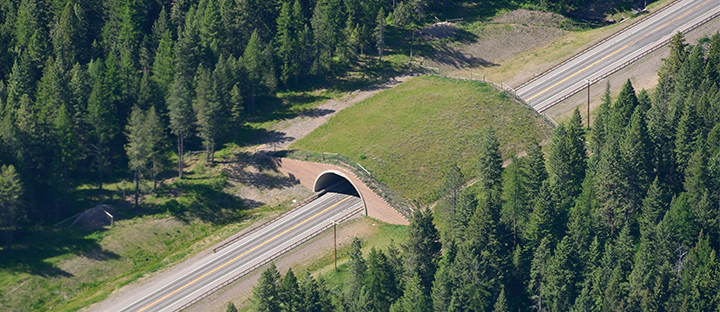Yellowstone to Yukon Conservation Initiative (Y2Y) celebrates the news that Confederated Salish and Kootenai Tribes (CSKT) have received a federal grant to continue wildlife connectivity work in an important part of the Yellowstone to Yukon region.
More than $30-million US from the Nationally Significant Federal Lands and Tribal Projects program will rehabilitate a section of US-93 north of Missoula, MT through the Ninepipe and Post Creek sections with various safety and infrastructure improvements.
The road, known as The People’s Way crosses the Mission Valley and is heavily used by both recreational and commercial traffic. Sadly, since 2018 at least 11 grizzly bears have been killed by vehicles on this stretch of road.
Crucially, this funding will advance phase two of a series of wildlife crossings and fencing, contributing to the already remarkable success and collaboration achieved so far from CSKT, Montana Department of Transportation and various environmental non-government organizations, including Y2Y. Adding to the 117 structures that already exist in the 3,400 kilometer (2,100 mile) long Yellowstone to Yukon region will continue to make safe passage for wildlife across roads possible.
“We appreciate the excitement our community has shown surrounding this project,” says Rich Janssen, department head of natural resources at CSKT. “This portion of US-93 is in great need, and we look forward to diving into the next phase in the coming months. One of our main goals with this project is protecting area wildlife and increasing resources to protect our homeland. This funding will help us work towards this effort.”
Addressing a major safety and biological problem
In the late 1980s, Montana Department of Transportation proposed expanding US-93, which was then regarded as the state’s most hazardous route for both humans and animals, from a two- to four-lane road due to safety concerns.
As the highway crosses reservation lands, CSKT voiced concerns for natural, cultural, recreational, and scenic resources. Particularly, they raised the additional threats an expanded, faster road posed to animals who live there including grizzly bears, elk, deer and bullhead trout. Highway 93 poses a significant barrier to wildlife and their need to find food, mates and habitat. For the Salish, Kootenai, and Pend d’Orielle people of CSKT, protecting and safeguarding animals is a priority.
Building “spirit of place”
A solution was reached in 1999, when Montana Department of Transportation, CSKT, and the Federal Highway Administration established a new design concept and approach for the project.
What was proposed was a consideration for the highway to be a “respectful visitor to these lands”. This meant adaptations to the traditional design process, particularly considering how the land should shape the road — instead of the other way around.
This “spirit of place” approach meant adjustments such as the road curving with the landscape instead of being a straight shot through, and considerations to how people and wildlife experienced the highway that cut through habitat and CSKT communities. Drawing from the new knowledge that wildlife crossings are a proven solution for safety and wildlife connectivity, the plans also included crossing structures and fencing to guide wildlife to them.
Keeping them connected
Today, the first section has been completed, which is a 90.6-kilometer (56-mile) section of US-93, that has a series of 38 crossings, including an overpass, and dozens of underpasses such as open span bridges, culverts and jump-outs that allow species of all kinds to get from one side of the highway to the other.
Tribal knowledge played a role in shaping the network of wildlife crossings, drawing upon expertise in wildlife biology, wetlands, and native plants, and also in highlighting culture and language.
Grizzly and black bears, elk, moose and cougars, but also frogs and toads, turtles, and fish can now stay connected. The road guides those travelling on it past the Bison Range, mountains, wetlands, rivers and scenic views, while preventing costly and deadly wildlife-vehicle collisions.
What lies ahead for Highway 93
“This funding is exciting news. It demonstrates CSKT’s continued leadership along with federal commitment. Crossings in Banff National Park and on Highway 93 on the CSKT lands are recognized as some of North America’s most advanced and expansive wildlife crossing initiatives. By incorporating Indigenous knowledge and western science, we can work together in this transboundary region to make it safer for people and wildlife,” says Pelah Hoyt, Y2Y’s director of landscape connectivity.
One of Y2Y’s priorities is conserving wildlife corridors and connectivity across the Yellowstone to Yukon region. This includes working with willing landowners who want to improve wildlife movement on their properties and ensuring that infrastructure such as wildlife crossings over busy roads are built to keep wildlife connected.
For years, Y2Y and partners have studied key wildlife corridors, and advocated for funding in infrastructure to improve safety. As one of the organizations who advocated for funding and supported the grant application, we are pleased with this outcome.
This investment on Highway 93 will directly improve connectivity in a grizzly bear recovery zone in between protected areas and help restore the ecological integrity of this important landscape.
Adding to this good news, a recent bipartisan infrastructure package includes $350 million to construct wildlife road crossings, a historic amount that represents the largest investment in wildlife crossings in American history.
We here at Y2Y are excited by the prospect of working with Indigenous and non-Indigenous governments, partners, and communities to make more projects like this a reality.



